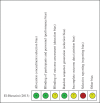Comparison of Intramedullary Nail Versus Conventional Ilizarov Method for Lower Limb Lengthening: A Systematic Review and Meta-Analysis
- PMID: 28589635
- PMCID: PMC6584216
- DOI: 10.1111/os.12330
Comparison of Intramedullary Nail Versus Conventional Ilizarov Method for Lower Limb Lengthening: A Systematic Review and Meta-Analysis
Abstract
The objective of this systematic review and meta-analysis was to compare the lengthening and then nailing (LATN) technique to the conventional Ilizarov method for limb lengthening. A systemic search of potential relevant literature was performed in databases, including the Cochrane Central Register of Controlled Trials (CENTRAL), PubMed, EMBASE, and the ISI Web of Knowledge, from their inception to 22 May 2015 using medical subject heading (MeSH) terms "Ilizarov," "bone lengthening," or "intramedullary nail." A total of 89 titles and abstracts were preliminarily reviewed, of which 4 studies eventually satisfied the eligibility criteria, consisting of one randomized controlled trial (RCT), two clinical controlled trials and one retrospective cohort study. A total of 354 limbs were included in the study, among which 183 were lengthened over an intramedullary nail, and 171 limbs were lengthened conventionally. The mean difference (MD) was -50.21 for the external fixation index between the two groups (95% CI, -51.83 to -48.59; P < 0.00001) with high heterogeneity (I2 = 99%); no significant difference in length was gained (MD = -0.30, 95% CI = -0.72 to 0.12; P = 0.16) with high heterogeneity (I2 = 80%); and there was high significant difference for the consolidation index (MD = -19.97; 95% CI, -21.59 to -18.35; P < 0.00001) with high heterogeneity (I2 = 100%). The overall rate of complications was relatively low, and differed significantly between the two groups. Through this meta-analysis, we find that LATN is superior to the conventional method in regards to the external fixation index and the consolidation index, which means that LATN is an effective technique that can decrease the time needed in external fixation.
Keywords: Ilizarov; Intramedullary nail; Lower limbs lengthening; Meta analysis.
© 2017 Chinese Orthopaedic Association and John Wiley & Sons Australia, Ltd.
Figures










Similar articles
-
What Is the Relative Effectiveness of the Various Surgical Treatment Options for Distal Radius Fractures? A Systematic Review and Network Meta-analysis of Randomized Controlled Trials.Clin Orthop Relat Res. 2021 Feb 1;479(2):348-362. doi: 10.1097/CORR.0000000000001524. Clin Orthop Relat Res. 2021. PMID: 33165042 Free PMC article.
-
Systemic pharmacological treatments for chronic plaque psoriasis: a network meta-analysis.Cochrane Database Syst Rev. 2021 Apr 19;4(4):CD011535. doi: 10.1002/14651858.CD011535.pub4. Cochrane Database Syst Rev. 2021. Update in: Cochrane Database Syst Rev. 2022 May 23;5:CD011535. doi: 10.1002/14651858.CD011535.pub5. PMID: 33871055 Free PMC article. Updated.
-
Antioxidants for female subfertility.Cochrane Database Syst Rev. 2017 Jul 28;7(7):CD007807. doi: 10.1002/14651858.CD007807.pub3. Cochrane Database Syst Rev. 2017. Update in: Cochrane Database Syst Rev. 2020 Aug 27;8:CD007807. doi: 10.1002/14651858.CD007807.pub4. PMID: 28752910 Free PMC article. Updated.
-
Electronic cigarettes for smoking cessation.Cochrane Database Syst Rev. 2022 Nov 17;11(11):CD010216. doi: 10.1002/14651858.CD010216.pub7. Cochrane Database Syst Rev. 2022. Update in: Cochrane Database Syst Rev. 2024 Jan 8;1:CD010216. doi: 10.1002/14651858.CD010216.pub8. PMID: 36384212 Free PMC article. Updated.
-
Electronic cigarettes for smoking cessation.Cochrane Database Syst Rev. 2021 Sep 14;9(9):CD010216. doi: 10.1002/14651858.CD010216.pub6. Cochrane Database Syst Rev. 2021. Update in: Cochrane Database Syst Rev. 2022 Nov 17;11:CD010216. doi: 10.1002/14651858.CD010216.pub7. PMID: 34519354 Free PMC article. Updated.
Cited by
-
Efficacy comparison of trifocal bone transport using unilateral external fixator for femoral and tibial bone defects caused by infection.BMC Surg. 2022 Apr 12;22(1):141. doi: 10.1186/s12893-022-01586-z. BMC Surg. 2022. PMID: 35413897 Free PMC article.
-
Is core decompression and bone marrow concentrate with demineralized bone matrix and platelet-rich fibrin suitable for treating femoral head osteonecrosis?J Hip Preserv Surg. 2024 Sep 14;11(4):263-270. doi: 10.1093/jhps/hnae031. eCollection 2024 Dec. J Hip Preserv Surg. 2024. PMID: 39839553 Free PMC article.
-
Lengthening Nails for Distraction Osteogenesis: A Review of Current Practice and Presentation of Extended Indications.Strategies Trauma Limb Reconstr. 2020 Jan-Apr;15(1):54-61. doi: 10.5005/jp-journals-10080-1451. Strategies Trauma Limb Reconstr. 2020. PMID: 33363643 Free PMC article. Review.
-
Motorized Internal Limb-Lengthening (MILL) Techniques Are Superior to Alternative Limb-Lengthening Techniques: A Systematic Review and Meta-Analysis of the Literature.JB JS Open Access. 2020 Dec 30;5(4):e20.00115. doi: 10.2106/JBJS.OA.20.00115. eCollection 2020 Oct-Dec. JB JS Open Access. 2020. PMID: 38090621 Free PMC article.
-
Electromagnetic Rod in Lower Limb Lengthening: A Technical Note for Shaft Osteotomy.Strategies Trauma Limb Reconstr. 2019 Sep-Dec;14(3):139-141. doi: 10.5005/jp-journals-10080-1444. Strategies Trauma Limb Reconstr. 2019. PMID: 32742429 Free PMC article.
References
-
- Codivilla A. On the means of lengthening, in the lower limbs, the muscles and tissues which are shortened through deformity. 1904. Clin Orthop Relat Res, 1994, 301: 4–9. - PubMed
-
- Fischgrund J, Paley D, Suter C. Variables affecting time to bone healing during limb lengthening. Clin Orthop Relat Res, 1994, 301: 31–37. - PubMed
-
- Ilizarov GA. Tranosseous Osteosynthesis, 1st edn. Berlin: Springer, 1992.
-
- Ilizarov GA. Clinical application of the tension‐stress effect for limb lengthening. Clin Orthop Relat Res, 1990, 250: 8–26. - PubMed
-
- Nho SJ, Helfet DL, Rozbruch SR. Temporary intentional leg shortening and deformation to facilitate wound closure using the Ilizarov/Taylor spatial frame. J Orthop Trauma, 2006, 20: 419–424. - PubMed
Publication types
MeSH terms
LinkOut - more resources
Full Text Sources
Other Literature Sources
Medical

